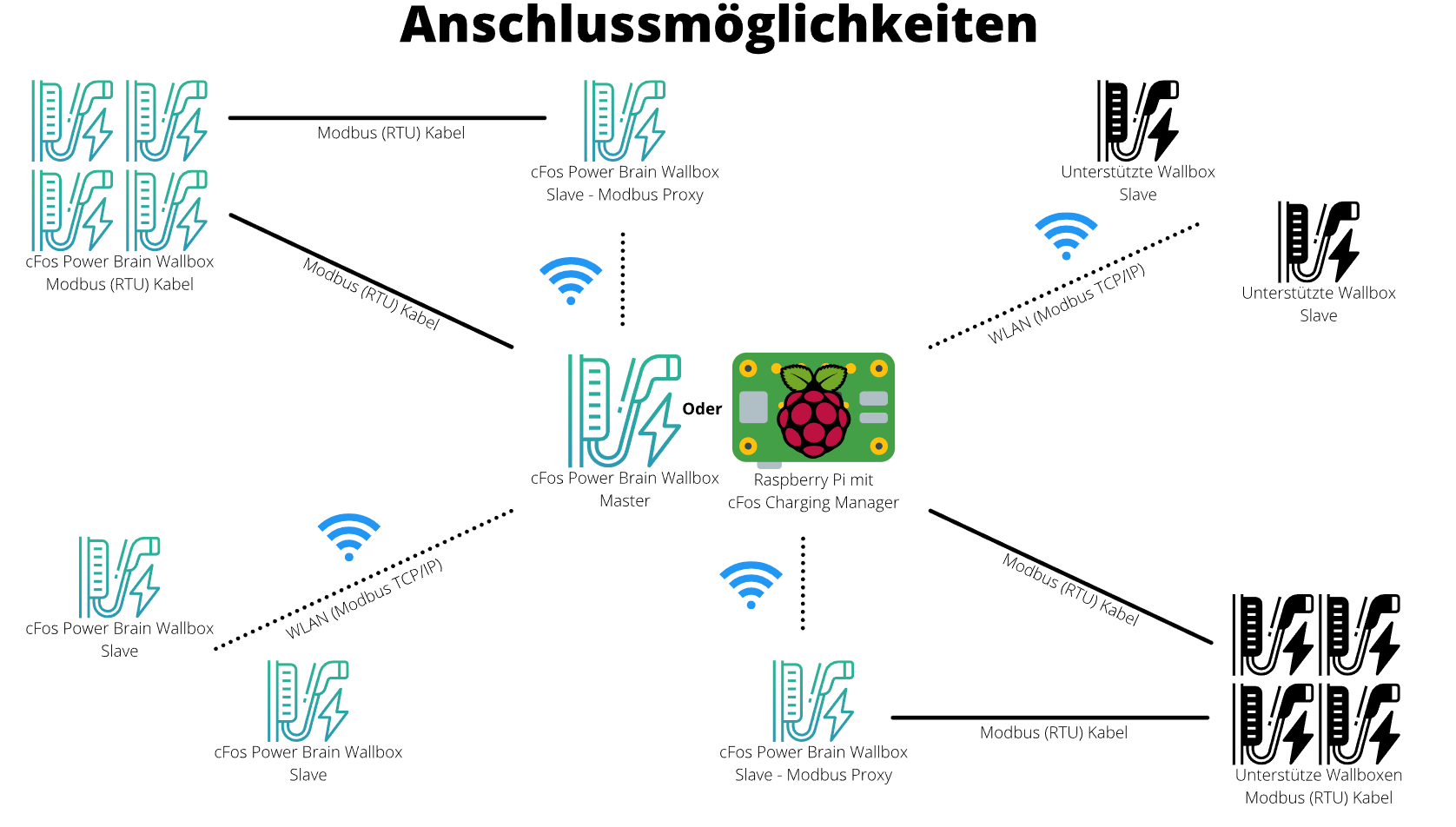Documentation
Cabling options
Below we show you the cabling options for multiple EVSEs on our cFos Charging Manager. The cFos Charging Manager is integrated with our cFos Power Brain Wallbox and is available as a standalone version for a one-off fee per charging point. You can then run this on a Raspberry Pi or Windows PC.
If you have your boxes controlled via the cFos Charging Manager, the following advantages result:
- Intelligent load management:
When several EVSEs are used simultaneously, the maximum possible grid connection power is often exceeded. This can save you the cost of upgrading your power connection. For single-family homes, the callable grid connection power is usually 14.5kW, if there is an electric water heating system, 34 kW. - PV Surplus Charging (Solar Surplus Charging):
With the cFos Charging Manager and a solar installation, you can ensure that your car is only charged when solar surplus power is available. Surplus = generation minus domestic consumption - Compatibility with a large number of supported wallboxes:
Retrofitting load management and PV surplus charging to your existing wallboxes. These functions are usually only available on high-priced wallboxes - Terminating resistor 120 Ohm, 1/4 Watt
- Everything at a glance: Monitor and control electricity meters, EVSEs and solar power systems with one software package
If you want to set up a charging park with more devices, you can use Modbus TCP/IP (WLAN), Modbus RTU (cable connection) and Modbus Proxy without a mix (see below). 
Modbus RTU connection
Important: For the Modbus RTU connection we strongly recommend a twisted pair connection. Telephone lines and any type of network cable are sufficient for this purpose.- Modbus wiring
- One USB <-> RS485 adapter (FTDI, virtual COM port) per Modbus RTU. You can operate approx. 20 devices on one bus.
- USB isolator
- Terminating resistor 120 Ohm, 1/4 Watt
- Network switches
- Our optional Modbus kit contains everything you need for the cabling
Note:
The maximum number of Modbus devices on one cable should not exceed approx. 20. After that, the cycle time increases, as the cFos Charging Manager can only query all devices per bus one after the other.
Modbus Proxy Connection
Our cFos Power Brain Wallboxs support a Modbus proxy. Up to 20 Modbus devices are connected via Modbus RTU (cable) to a cFos Power Brain Wallbox or to a Modbus adapter on a Windows PC or Raspberry Pi. In this case, the Charging Manager communicates with all devices via Modbus TCP/IP protocol. The proxy then forwards the Modbus requests to the Modbus RTU 2-wire connection.
This feature is particularly useful for large installations or if you do not want to set up comprehensive WLAN coverage for your charging infrastructure
Modbus TCP/IP connection (WLAN)
Commissioning
There are several ways to achieve sufficient WLAN network coverage:
- WLAN repeater: repeats the WLAN signal and must be seamlessly extended.
- DLAN: Internet via the power line. The WLAN signal is then sent from a socket near the EVSE.
- WLAN access points: The access point is connected to the existing network via a network cable. End devices then dial into the access point via WLAN.
